
1. Vernacular Architecture
2. Classical Architecture
3. Romanesque Architecture
4. Gothic Architecture
5. Tudor Architecture
6. Renaissance Architecture
7. Baroque Architecture
8. Neoclassical Architecture
9. Industrial Architecture
10. Neogothic Architecture
11. Victorian Architecture
12. Beaux-arts Architecture
13. Art Nouveau Architecture
14. Art Deco Architecture
15. Bauhaus Architecture
16. Modernist Architecture
17. Brutalist Architecture
18. Post-modern Architecture
19. Neofuturist Architecture
20. Sustainable Architecture

Never heard of this term? We wouldn’t dare blame you if you didn’t, as it is way less prominent than, let’s say, Gothic or Victorian architecture. But in a way, vernacular architecture is where it all began.
Vernacular buildings are, simply put, traditional. They evolved in a specific place using local materials and are perfectly adjusted to that area’s landscape and weather conditions. Thus, igloos, Swiss chalets, American ranch houses, and the stilt houses of Nicaragua and Papua New Guinea all fall within this category. Modern urban dwellings also fall within this category.
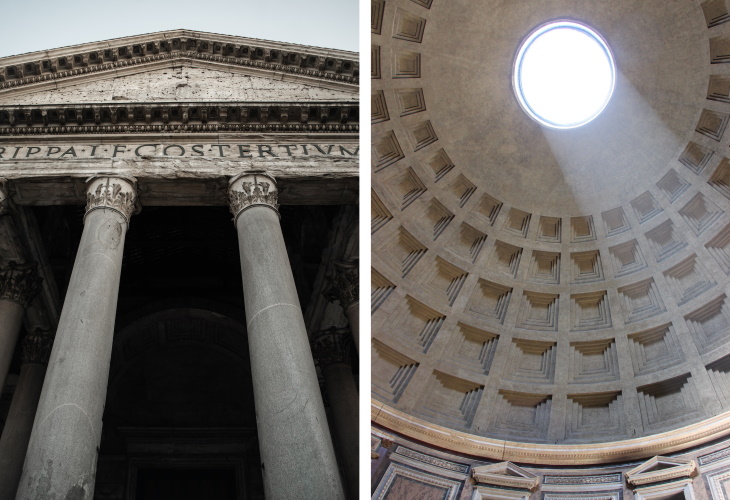
What does the term “classical” even mean in architecture? Traditionally, it refers to the buildings of Ancient Greece and Rome. The simplest and most representative example of this is a rectangular temple supported by rows of columns, just like the Acropolis of Athens.
Since this style includes structures that were built centuries apart (500 BC - 300 AD), the variety of constructions that fall within this style is staggering. The Greek order of columns alone - which includes Doric, Ionic, and Corinthian columns - showcases the development or architectural prowess through the ages.
Key principles: symmetry, geometry, and proportions.
In the Roman era, marble and brick were supplemented by concrete, which allowed them to develop more complex arches and later domes. These features became the hallmarks of the Classical style, as can be easily observed in two more iconic examples of Classical architecture - the Colosseum and the Pantheon in Rome.
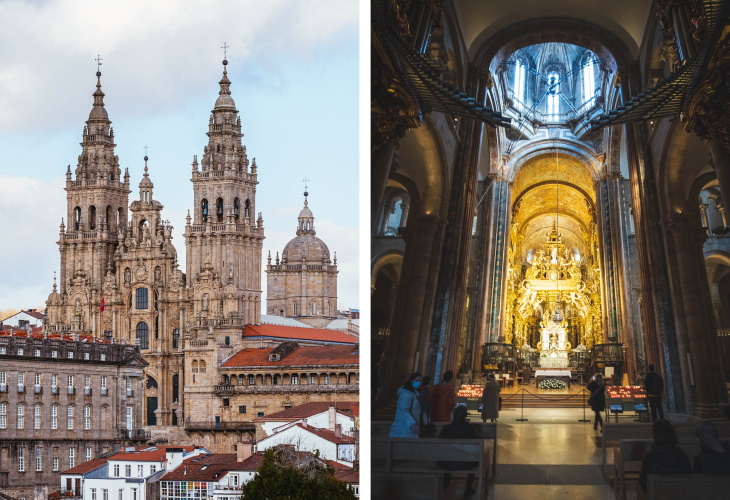
After the collapse of the Roman Empire, most of Europe fell into a period of war and division we now refer to as the Middle Ages. And the architecture of the time completely reflects this historical context. Buildings had to be strong and able to protect their inhabitants from invasions. Hence, ornamentally-decorated marble columns were often sacrificed in favor of sturdy brick walls with small windows, buttresses, thick pillars, and tall towers.
But the Classical ideals of centuries past were not entirely forgotten. Semicircular arches and columns, as well as a focus on symmetry, remain prominent features in Romanesque buildings.
Churches are the best examples of the Romanesque style. One of the most important Ecclesiastical buildings is the Santiago de Compostela Cathedral in Spain. This prominent structure was completed during the Crusades, and it took 137 years to finish!
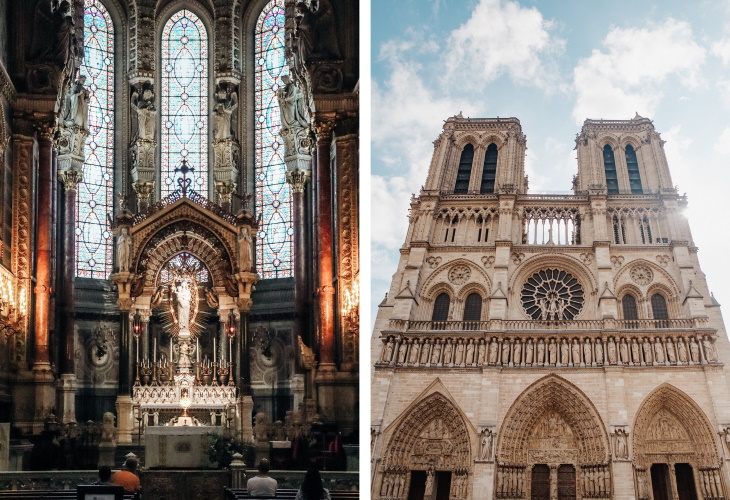
Gothic architecture is what most people would recognize as quintessentially Medieval. The majestic churches of the period spanning from 900-1300 AD seemingly reach the heavens. And this is no coincidence, as this period in European history marks the height of Christian influence. The Gothic cathedral, then, was meant to represent people’s dedication to God.
Gothic buildings are characterized by intricate stonework, flying buttresses, pointed arches, and vaulted columns. In this way, the Gothic style is the direct descendant of Romanesque architecture.
Originally, Gothic architecture was known as Opus Francigenum, which is translated as “French work” from Latin. This early name hints at the style’s country of origin - France. So, it’s no surprise that one of the most famous examples of Gothic architecture is the Notre-Dame Cathedral in Paris. Other prominent buildings of this period are the Reims Cathedral in France, the Canterbury Cathedral in England, and the Milan Cathedral in Italy.
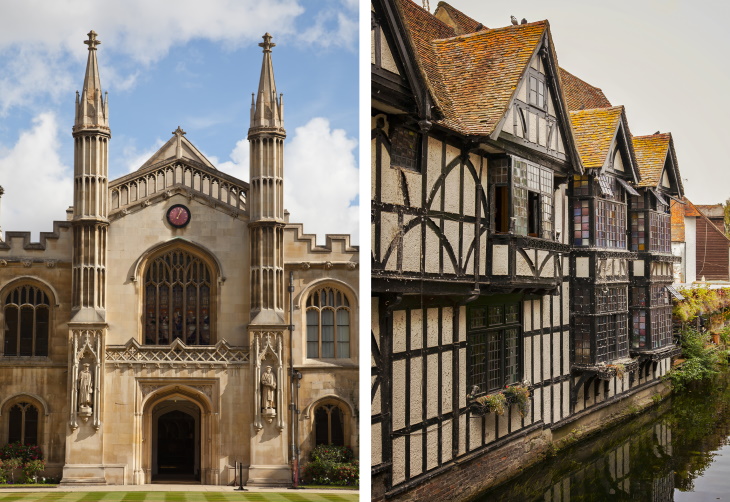
The late 15th century marked the dawn of the Tudor dynasty in England. This period also coincides with the beginning of a new style in architecture that combined Gothic-style constructions with early Renaissance decorations. These new buildings would be labeled as “Tudor-style,” as their appearance would roughly coincide with Henry VII’s ascension to the throne in 1485.
Interestingly, most examples of Tudor architecture are not massive buildings like castles and palaces, but secular and even residential buildings. That’s because all those Early Medieval castles were no longer used by the masses, and everyone except for the nobility moved to smaller residential structures. Places like King’s College Chapel in Cambridge and the Hampton Court Palace are the few exceptions to this rule.
The exterior of a typical Tudor building features a gable roof with ornamental chimneys, brick facades with wooden planks as decor, and large rectangular or oriel windows. The decorative Renaissance motifs continued in the interior too: the ceilings were adorned with molded plaster and the walls were covered in wooden paneling.
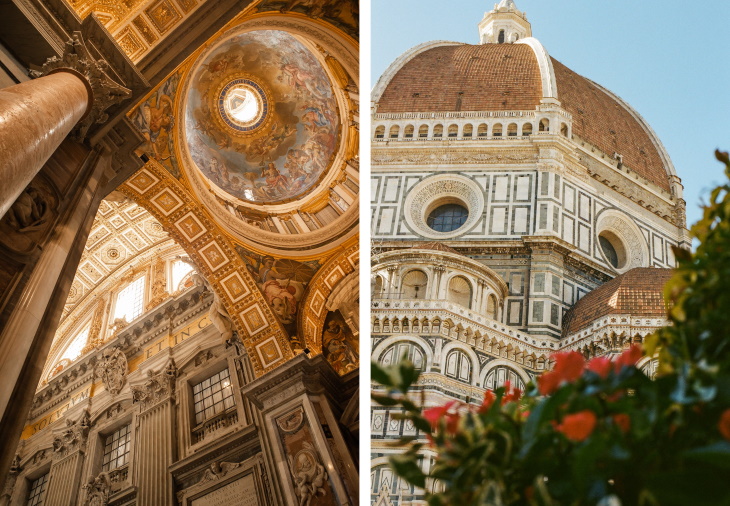
The Renaissance was the era when European artists rediscovered the beauty of Ancient Greek and Roman art. Inspired by the natural but idealistic depictions they saw in antique sculpture and architecture, Renaissance artists and architects focused on the idea of geometric forms, symmetry, and proportion.
Iconic churches like St. Peter’s Basilica, the Sistine Chapel, and Palazzo Farnese are all excellent examples of this elegant style. Renaissance-era structures often feature simple geometrical shapes that starkly contrast with the irregular shapes of Gothic buildings.
Among the key elements of Renaissance architecture are the orderly arrangement of columns, and the wide use of domes, niches, and arches. The abundance of interior decorations like frescos, sculptures, and paintings that depict humans in natural forms is another prominent feature.
Related Article: 10 Beautiful Examples of Renaissance Architecture
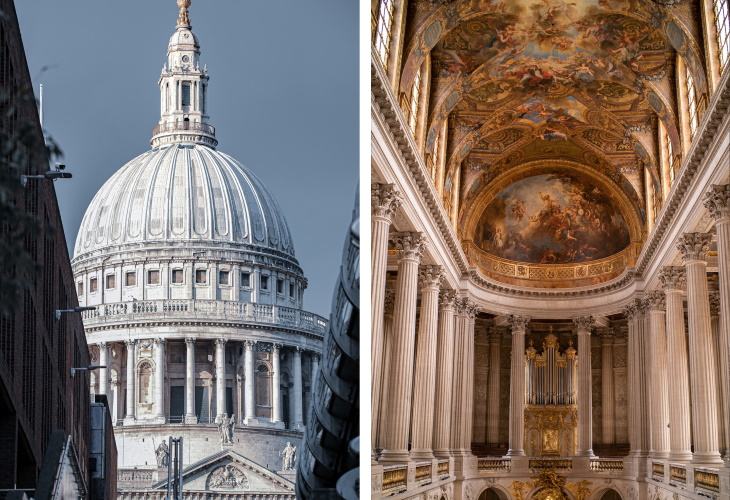
The 16th century is a time in history when powerful monarchs ruled over Europe, and the church attempted to re-establish its former grip over the masses. One of the ways both tried to project power was through pompous and dramatic buildings. And that’s how we got some of the most extravagant and over-the-top buildings in all of history, such as the Palace of Versailles in France, St. Peter’s Square in the Vatican, and St. Paul’s Cathedral in London.
To the Baroque man, structural elements like facades, ceilings, and walls were blank canvases to be decorated - and the more decor, the better! Instead of the angularity of Medieval structures, Baroque masters preferred shapes that, as they believed, better appealed to the eye: ovals, domes, and other rounded and fluid forms.
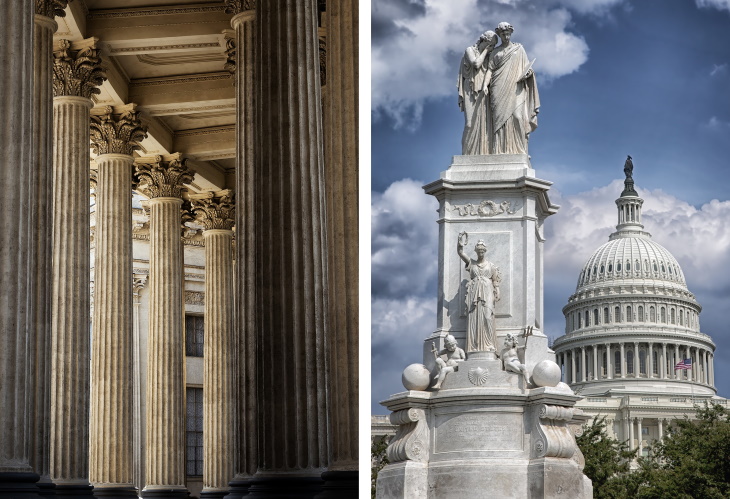
Just like in fashion, we see the same “trend” returning over and over throughout the ages in architecture too. That’s precisely what happened to Classical architecture in the 18th century. It was reimagined and revived under a new name - Neoclassical architecture.
In a way, the simplicity of Neoclassical architecture was the opposition to Baroque architecture and the monarchical ideals it was associated with. All this fell in line with the newly-established United States, a country that was more closely modeled after the Roman Republic than the monarchies that birthed it. That is why most Americans are very familiar with this style, as famous governmental buildings like the White House and US Capitol are closely aligned with Neoclassicism.
Buildings executed in the Neoclassical style have the same clean, symmetrical, and elegant lines as Ancient Greek and Roman temples. You’ll also find many familiar elements of Classical architecture, particularly the dramatic use of columns and Classical ornamentation.
Related Article: 15 Superb Colonial-Era Buildings Across the Globe

Like Classical architecture, the Medieval Gothic style inspired later generations. Sometimes considered an offshoot of the Victorian style, Neogothic Architecture (see below) actually began somewhat earlier in the 1740s and continued until the end of the Victorian Era. This new current intended to mimic Gothic buildings, hence the other name of the style - Gothic Revival.
The peculiarity of this style is that, oftentimes, you won’t be able to tell a genuine Gothic and a Neogothic cathedral apart. Upon closer inspection, you’ll be able to see a greater emphasis on ornamentation and modern details (like lamps and chandeliers) in these newer buildings. Excellent examples of this style are the Trinity Church in New York City, the Cologne Cathedral in Germany, and the John Rylands Library in Manchester.
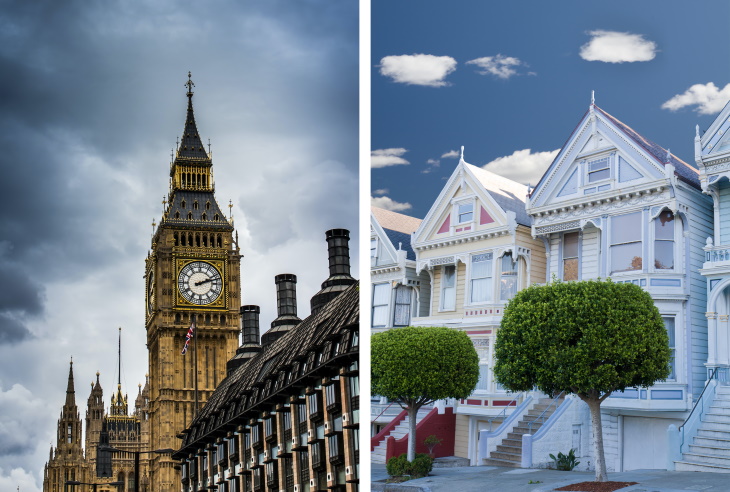
Like the term Tudor architecture, Victorian architecture refers to a particular era of English history, namely, the reign of Queen Victoria (1837-1901). As you may have guessed, this architectural style began in England, but due to Britain’s massive colonial influence, examples of Victorian buildings are scattered across the globe.
One can spot the characteristic steep roofs with towers and turrets, the red brick facades, the textured shingles, and the wrap-around porches of Victorian houses across England, the United States, India, Australia, Canada, and many other countries. Structurally, Victorian buildings are a mashup of different elements, including those from Gothic, Romanesque, and Tudor architecture.
Like Tudor-style buildings, many Victorian structures are residential, although several larger constructions can also be named. For instance, the Palace of Westminster, Big Ben, and the Royal Albert Hall in London all belong to this style. Probably the most famous example of domestic Victorian dwelling is the Painted Ladies (or Postcard Row) in San Francisco.
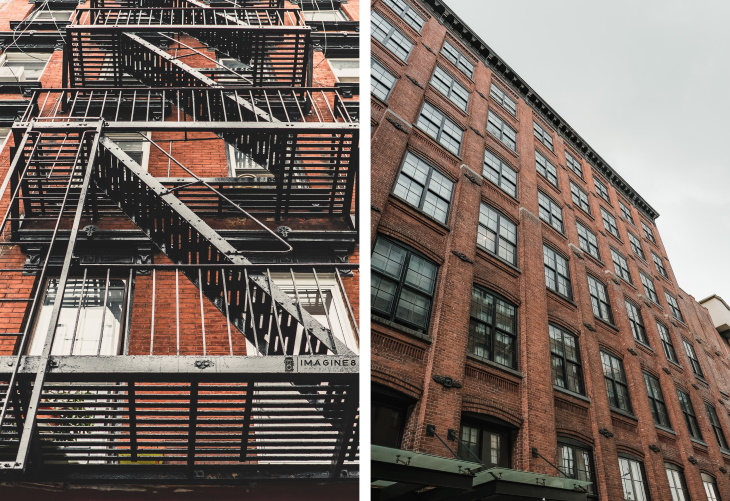
Once again, we see how historical events can influence what people decide to build. The onset of the Industrial Revolution in Britain between 1760-1840 created the need for brand-new types of buildings: large factories, warehouses, distilleries, power plants, and other functional structures. Many of these early industrial buildings can still be seen across Britain, the United States, and other early industrial centers.
Industrial buildings were built quickly, so they had to combine functionality and minimal decorations. They also had to be big enough to contain heavy machinery and workers, so these spaces are typically rather large and open.
In the 20th century and now, architects found a charm in these industrial buildings, and later on, the term also became associated with buildings with unfinished concrete or brick, apparent ducts, and pipes. This industrial aesthetic is popular even today.
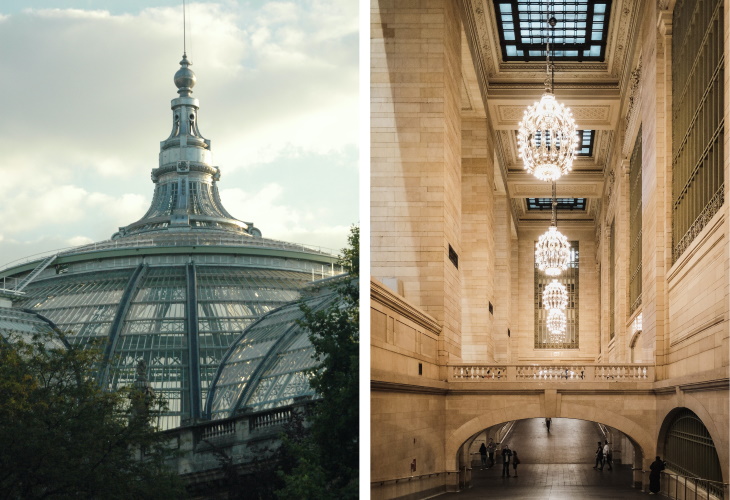
Like many more contemporary art styles, beaux art started in Paris in the mid-1830s. This school of art is known for utilizing many contemporary materials, especially glass and iron, in the creation of buildings that reference previous historical styles, such as Gothic, Neoclassical, and Renaissance architecture.
To visualize a building in this style, think of the Grand Central Terminal or the Metropolitan Museum of Art in New York.
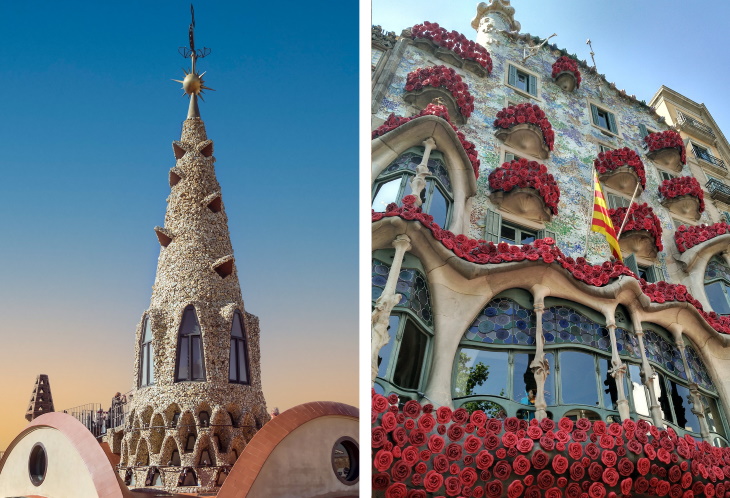
Art Nouveau artists believed that beauty, art, and design should be part of everyday life and shouldn't be restricted to museums. Of course, that includes buildings executed in this elegant and beautiful style. Buildings constructed in this style have many curved lines, inspired by organic shapes of flowers, plants, animals, and the human form. These organic shapes combined with decorative elements made of metal and stained glass are seen in Art Nouveau buildings all around the world.
The first Art Nouveau buildings were developed by the Belgian architect Victor Horta. However, many other architects, including the Spanish architect Antoni Gaudi and the Frenchman Hector Guimard also achieved great fame by working in this style.
Antoni Gaudi’s Casa Batlló in Barcelona, the Majolikahaus and the Secession Building in Vienna, and the Old England Building in Brussels are all perfect examples of Art Nouveau in architecture.
Related Article: 15 of the Most Beautiful Buildings in Art Nouveau Style

Art Deco is Art Neveau’s younger sister. Both styles dominated Europe and the US in the 1920-1930s. However, Art Nouveau focuses on elegant curves and organic features, whereas Art Deco features more sharp angles and geometric shapes. Although Art Deco originated in France, it flourished in the United States.
You don’t need to look further than the Manhattan skyline to understand what Art Deco buildings look like. The Empire State Building, the Chrysler building, the Radiator Building, and the Rockefeller Center are all executed in this style.
Metal decor, often in the shape of pyramids, sunbursts, and geometric shapes against contrasting glass windows is common for an Art Deco building. Generally speaking, this style encompasses the aesthetic of the Roaring Twenties.
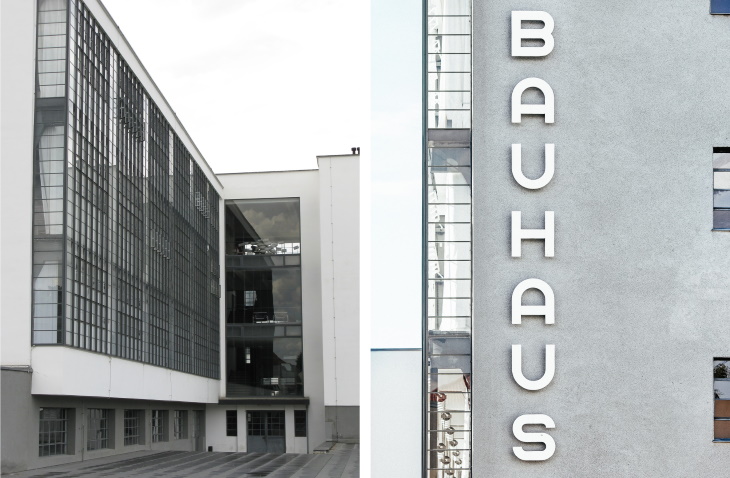
The Bauhaus art school in Germany influenced all modern architecture, art, and design. No small feat, right? Founded by Walter Gropius, the school had a utopian aim to rebuild society after World War I through art. The use of technological advancements, an accent on functionality, and a minimalist approach to design were the driving forces for Bauhaus creators. And we still see all of these features everywhere around us, even in our homes, today.
World War II halted the development of Bauhaus, and the artists of the school scattered across the globe, taking their visionary principles of design and architecture with them. That’s why you’ll see Bauhaus buildings worldwide - from Bauhaus in Dessau, Germany to the Gropius House in Lincoln, Massachusetts, and the Poli House in Tel Aviv.
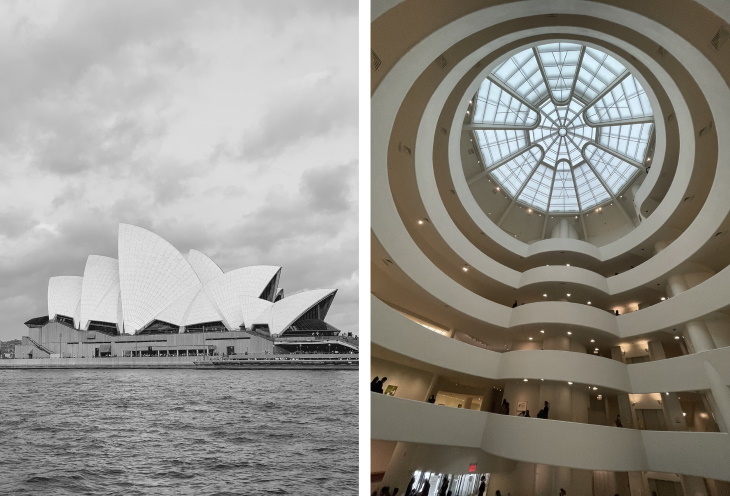
Modernist architecture is an umbrella for many different styles of the first half of the 20th century. The features that unite all modernist styles are the simplicity of form, the accent on functionality, and the absence of ornamentation. Modernists also took advantage of new methods of working with steel, iron, glass, and concrete.
Frank Lloyd Wright’s "Fallingwater" home in the United States and Le Corbusier’s Villa Savoye in France exemplify this style. The influences of modernist architects are still felt today; the ability to combine design, architecture, and natural landscapes is a major guiding principle of contemporary buildings.
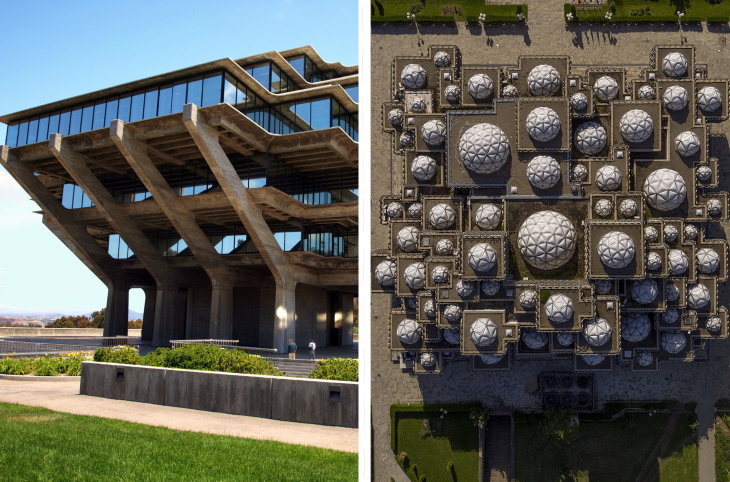
Brutalist architecture is essentially the post-World War II iteration of modernism. The style began in the 1950s and was prominent until the 1970s. These are simplistic, geometric buildings made of metal and concrete. To some, the heavy appearance and complete lack of ornamentation look ugly, and overall, this style is controversial and ever-polarizing.
Interestingly, the term Brutalism comes from the French word for raw cement - béton brut. The Geisel Library at the University of California, San Diego, and 945 Madison Ave (the Breuer Building) in New York City are two great examples of this style.
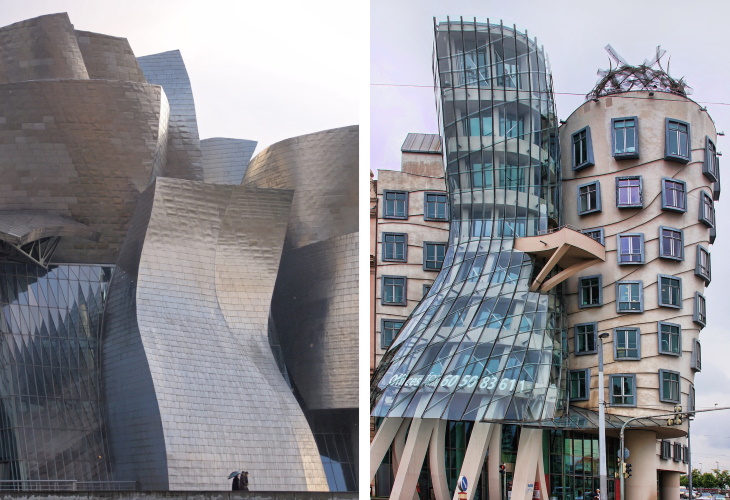
From the 1929 Great Depression until the 1970s, Modernist architecture triggered more and more criticism. Exhausted by the austerity of modernist architecture, post-modernist architects responded with a new, artistic, and expressive style. The facade of a postmodern building is decorative and not limited by just one style of architecture. Instead, it’s a mix of various styles that, ideally, should result in an unexpected hybrid design.
The Guggenheim Museum in Bilbao, Spain, and the Dancing House in Prague are two great examples of post-modern architecture.
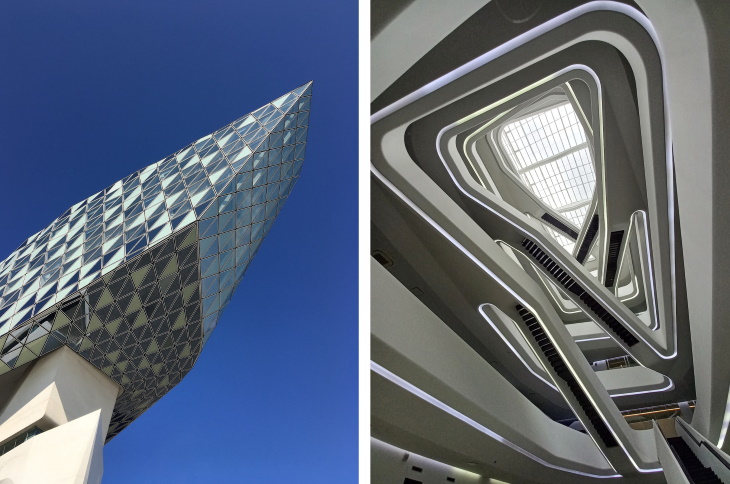
Here’s another new term in the vocabulary of architecture. Neofuturism refers to a style of architecture that takes advantage of new technologies to create novel and seemingly impossible structures and shapes. Neofuturist buildings seem to defy the laws of physics and appear as something you would only find in science fiction. Intriguing, right?
The main figure in the Neofuturist movement is the Iraqi-British architect Zaha Hadid. The award-winning architect created countless amazing projects, such as the 2020 Tokyo Olympic Stadium in Japan, the Heydar Aliyev Cultural Centre in Azerbaijan, and the Serpentine Sackler Gallery in Hyde Park, London. Even though Hadid passed away in 2016, the architect’s students carry on her work.
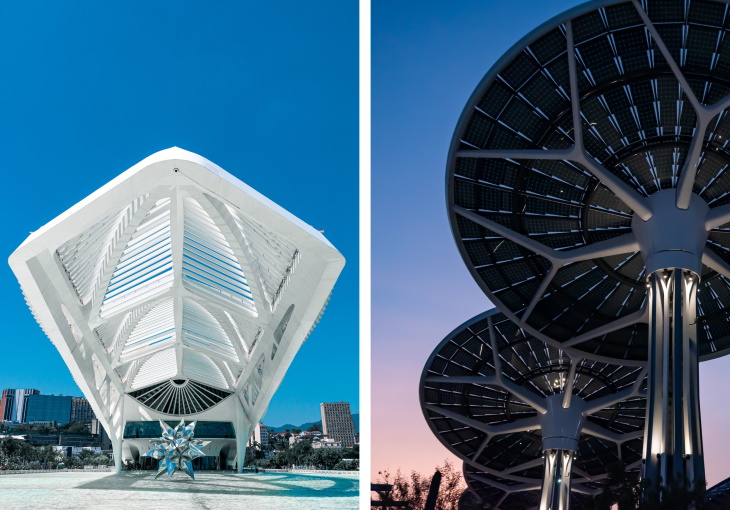
Sustainable architecture is the last and latest style of architecture on this list. And like many previous styles we discuss, it is a response to current societal issues. Sustainable buildings prioritize minimizing the negative environmental impact of urbanization by utilizing technological advancements.
Sustainable architecture aims to be efficient (ideally completely self-sufficient), and it minimizes the materials and energy necessary for the construction of the building. Two stunning examples of this novel approach to city-building are the “Terra” pavilion from Dubai Expo 2020 and the Museum of Tomorrow Rio de Janeiro, Brazil, by Santiago Calatrava.
References: The Spruce, Arch Daily, Barker Associates, Rethinking the Future, GQ Style, Artsy Net, Architecture and Design, Medieval Chronicles, Architectural Digest, Citeco.fr, Rmjm.com
Image Sources: Cammamu/ Wikimedia Commons, Ben Lunsford/ Wikimedia Commons, Codera 23/ Wikimedia Commons, Arben Llapashtica/ Wikimedia Commons